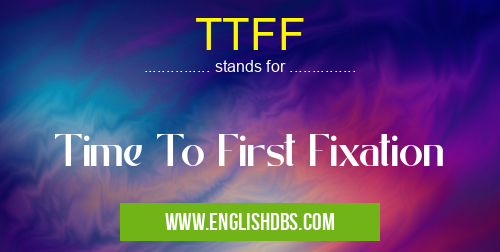What does TTFF mean in UNCLASSIFIED
TTFF stands for Time To First Fixation. It is a metric used in eye-tracking studies to measure the time it takes for a person to fixate their gaze on a specific target. TTFF is an important measure of visual attention and can be used to assess a variety of factors, such as visual processing speed, attentional control, and cognitive function.

TTFF meaning in Unclassified in Miscellaneous
TTFF mostly used in an acronym Unclassified in Category Miscellaneous that means Time To First Fixation
Shorthand: TTFF,
Full Form: Time To First Fixation
For more information of "Time To First Fixation", see the section below.
Importance of TTFF in Eye Tracking Studies
TTFF is a critical metric in eye-tracking studies as it provides insights into the following aspects:
- Cognitive processing speed: Shorter TTFF indicates faster visual processing, while longer TTFF may suggest slower cognitive functioning.
- Attentional control: Individuals with good attentional control can quickly shift their gaze to relevant targets, resulting in shorter TTFF.
- Target saliency: Targets that are more salient or visually distinctive tend to elicit shorter TTFF.
- Visual fatigue: Prolonged exposure to visual stimuli can lead to increased TTFF, indicating visual fatigue.
Applications of TTFF
TTFF measurements find applications in various fields, including:
- Cognitive psychology: Assessing attention, visual processing, and cognitive functioning.
- Human-computer interaction: Evaluating website design, user experience, and interface usability.
- Marketing research: Understanding how consumers process visual information in advertisements.
- Medical research: Diagnosing and monitoring neurological disorders that affect visual attention.
Essential Questions and Answers on Time To First Fixation in "MISCELLANEOUS»UNFILED"
What is TTFF (Time To First Fixation)?
TTFF measures the time it takes for a user's eyes to fixate on a specific target within a digital interface. It's an important metric for evaluating the effectiveness of a user interface (UI) and the user's cognitive load.
Why is TTFF important?
TTFF provides insights into how quickly users can identify and engage with crucial elements on a website or application. A shorter TTFF indicates that users can quickly find what they're looking for, improving their user experience.
How is TTFF measured?
TTFF is typically measured using eye-tracking technology that records the user's gaze patterns. The time from the moment the target appears on the screen to the moment the user's eyes fixate on it is recorded as the TTFF.
What is a good TTFF?
An optimal TTFF varies depending on the task and context. Generally, a TTFF of around 200-300 milliseconds is considered acceptable for simple tasks. For complex tasks, it may be longer.
How can I improve TTFF?
To improve TTFF, consider the following strategies:
- Make important elements visually prominent
- Use clear and concise language
- Organize content logically and hierarchically
- Minimize distractions and clutter
- Optimize page load times
Final Words: TTFF is a valuable metric in eye-tracking studies, providing insights into visual attention, cognitive processing speed, and attentional control. Its applications span across various fields, making it a key tool for researchers, designers, and medical practitioners. Understanding TTFF can help optimize visual experiences, assess cognitive function, and advance our understanding of visual behavior.
TTFF also stands for: |
|
| All stands for TTFF |
